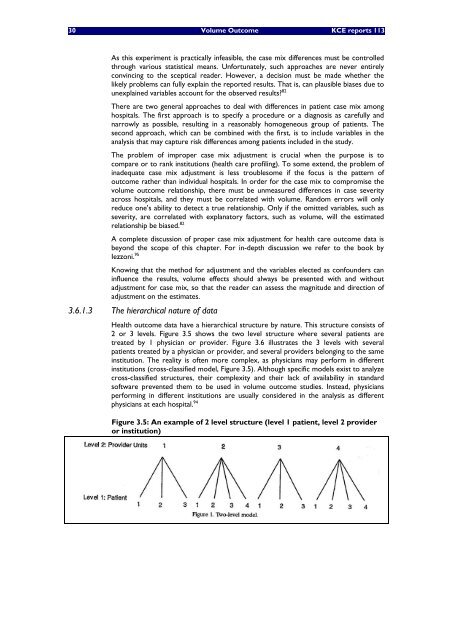Het volume van chirurgische ingrepen en de impact ervan op ... - KCE
Het volume van chirurgische ingrepen en de impact ervan op ... - KCE
Het volume van chirurgische ingrepen en de impact ervan op ... - KCE
You also want an ePaper? Increase the reach of your titles
YUMPU automatically turns print PDFs into web optimized ePapers that Google loves.
30 Volume Outcome <strong>KCE</strong> reports 113<br />
As this experim<strong>en</strong>t is practically infeasible, the case mix differ<strong>en</strong>ces must be controlled<br />
through various statistical means. Unfortunately, such approaches are never <strong>en</strong>tirely<br />
convincing to the sceptical rea<strong>de</strong>r. However, a <strong>de</strong>cision must be ma<strong>de</strong> whether the<br />
likely problems can fully explain the reported results. That is, can plausible biases due to<br />
unexplained variables account for the observed results? 82<br />
There are two g<strong>en</strong>eral approaches to <strong>de</strong>al with differ<strong>en</strong>ces in pati<strong>en</strong>t case mix among<br />
hospitals. The first approach is to specify a procedure or a diagnosis as carefully and<br />
narrowly as possible, resulting in a reasonably homog<strong>en</strong>eous group of pati<strong>en</strong>ts. The<br />
second approach, which can be combined with the first, is to inclu<strong>de</strong> variables in the<br />
analysis that may capture risk differ<strong>en</strong>ces among pati<strong>en</strong>ts inclu<strong>de</strong>d in the study.<br />
The problem of impr<strong>op</strong>er case mix adjustm<strong>en</strong>t is crucial wh<strong>en</strong> the purpose is to<br />
compare or to rank institutions (health care profiling). To some ext<strong>en</strong>d, the problem of<br />
ina<strong>de</strong>quate case mix adjustm<strong>en</strong>t is less troublesome if the focus is the pattern of<br />
outcome rather than individual hospitals. In or<strong>de</strong>r for the case mix to compromise the<br />
<strong>volume</strong> outcome relationship, there must be unmeasured differ<strong>en</strong>ces in case severity<br />
across hospitals, and they must be correlated with <strong>volume</strong>. Random errors will only<br />
reduce one’s ability to <strong>de</strong>tect a true relationship. Only if the omitted variables, such as<br />
severity, are correlated with explanatory factors, such as <strong>volume</strong>, will the estimated<br />
relationship be biased. 82<br />
A complete discussion of pr<strong>op</strong>er case mix adjustm<strong>en</strong>t for health care outcome data is<br />
beyond the sc<strong>op</strong>e of this chapter. For in-<strong>de</strong>pth discussion we refer to the book by<br />
Iezzoni. 95<br />
Knowing that the method for adjustm<strong>en</strong>t and the variables elected as confoun<strong>de</strong>rs can<br />
influ<strong>en</strong>ce the results, <strong>volume</strong> effects should always be pres<strong>en</strong>ted with and without<br />
adjustm<strong>en</strong>t for case mix, so that the rea<strong>de</strong>r can assess the magnitu<strong>de</strong> and direction of<br />
adjustm<strong>en</strong>t on the estimates.<br />
3.6.1.3 The hierarchical nature of data<br />
Health outcome data have a hierarchical structure by nature. This structure consists of<br />
2 or 3 levels. Figure 3.5 shows the two level structure where several pati<strong>en</strong>ts are<br />
treated by 1 physician or provi<strong>de</strong>r. Figure 3.6 illustrates the 3 levels with several<br />
pati<strong>en</strong>ts treated by a physician or provi<strong>de</strong>r, and several provi<strong>de</strong>rs belonging to the same<br />
institution. The reality is oft<strong>en</strong> more complex, as physicians may perform in differ<strong>en</strong>t<br />
institutions (cross-classified mo<strong>de</strong>l, Figure 3.5). Although specific mo<strong>de</strong>ls exist to analyze<br />
cross-classified structures, their complexity and their lack of availability in standard<br />
software prev<strong>en</strong>ted them to be used in <strong>volume</strong> outcome studies. Instead, physicians<br />
performing in differ<strong>en</strong>t institutions are usually consi<strong>de</strong>red in the analysis as differ<strong>en</strong>t<br />
physicians at each hospital. 94<br />
Figure 3.5: An example of 2 level structure (level 1 pati<strong>en</strong>t, level 2 provi<strong>de</strong>r<br />
or institution)

















